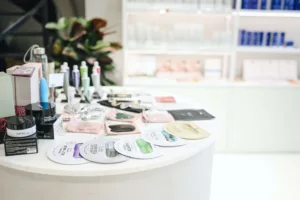Sustainability Starts with Your Beauty Bag

The beauty industry is evolving, with an increasing emphasis on sustainability and eco-consciousness. As consumers, we can play a significant role in reducing our environmental impact by making mindful choices in our beauty routines. This blog delves into the world of cosmetic carbon footprints, exploring the environmental impact of our beauty products and offering practical tips on how to make eco-friendly choices. By the end of this read, you’ll be equipped with the knowledge to curate a beauty routine that not only enhances your well-being but also reduces your cosmetic carbon footprint for a greener and more sustainable future.
Understanding the Cosmetic Carbon Footprint
The term “cosmetic carbon footprint” refers to the environmental impact of the beauty products we use daily. This impact stems from various factors, including product manufacturing, transportation, packaging, and disposal. It’s essential to understand this concept to make informed decisions about your beauty purchases.
- Product Ingredients: Many cosmetics contain ingredients derived from fossil fuels, contributing to greenhouse gas emissions during production and disposal.
- Packaging Waste: Excessive plastic packaging is a significant contributor to cosmetic carbon footprints. Single-use containers, non-recyclable materials, and excessive packaging contribute to plastic pollution.
- Transportation: The transportation of beauty products from manufacturing facilities to stores and consumers can result in carbon emissions, especially when products travel long distances.
Practical Steps to Reduce Your Cosmetic Carbon Footprint
Choose Eco-Friendly Brands: Look for beauty brands committed to sustainability. These brands often use eco-friendly packaging, source ethical ingredients, and prioritize responsible production practices.
- Check Product Ingredients: Opt for products with natural, organic, or sustainably sourced ingredients. Avoid products containing microplastics, petroleum-based ingredients, and chemicals harmful to the environment.
- Reduce Packaging Waste: Choose products with minimal packaging or those that use recyclable or biodegradable materials. Consider buying products in bulk or those with refill options to reduce single-use packaging.
- Buy Local: Support local beauty brands and reduce the carbon footprint associated with long-distance transportation. Local products often have a smaller environmental impact.
- DIY Beauty: Experiment with making your skincare and beauty products at home using natural ingredients. This reduces packaging waste and allows you to control the ingredients used.
- Reuse and Recycle: Whenever possible, reuse containers and packaging. Many beauty brands offer recycling programs or incentives for returning empty containers.
- Minimalist Approach: Adopt a minimalist approach to your beauty routine by using fewer products. This not only reduces your cosmetic carbon footprint but also simplifies your routine.
- Choose Multi-Use Products: Opt for products that serve multiple purposes, such as a lip and cheek tint or a moisturizer with sun protection. This reduces the number of products you need.
- Mindful Consumption: Before purchasing a new product, consider whether you truly need it. Avoid impulse buying and opt for quality over quantity.
- Support Sustainable Packaging Initiatives: Advocate for eco-friendly packaging by supporting brands that prioritize sustainable packaging options and encouraging others to do the same.

The Impact of Sustainable Packaging
Sustainable packaging plays a pivotal role in reducing the cosmetic carbon footprint. Brands are increasingly adopting eco-friendly packaging options to minimize waste and lower their environmental impact. Some innovative packaging solutions include:
- Refillable Containers: Brands like L’Occitane and Kjaer Weis offer refillable containers for their products. Customers can purchase refills, reducing the need for new packaging.
- Biodegradable Materials: Packaging made from biodegradable materials, such as bamboo, paper, or glass, minimizes plastic pollution and is easily compostable.
- Recycled Materials: Many brands are incorporating recycled materials into their packaging, further reducing the need for new resources.
- Minimalist Design: Streamlined packaging designs with fewer components reduce waste and are more environmentally friendly.
Reducing your cosmetic carbon footprint is a significant step toward a more sustainable and eco-conscious lifestyle. By making thoughtful choices in the beauty products you use, supporting eco-friendly brands, and advocating for sustainable packaging, you can contribute to a greener future while still enjoying your favorite beauty products.




